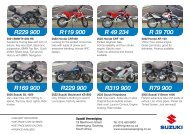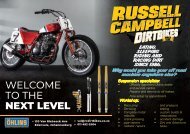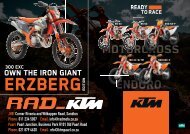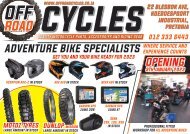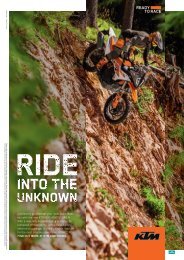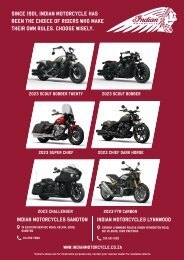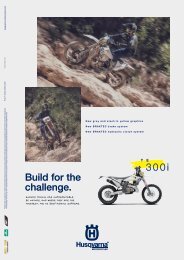You also want an ePaper? Increase the reach of your titles
YUMPU automatically turns print PDFs into web optimized ePapers that Google loves.
DON’T ‘BRAKE’ A SWEAT<br />
A reduction in weight because there’s less material and better<br />
heat dissipation is the main advantages. As with a lot of the<br />
designs we’ve just spoken about, the looks are almost certainly a<br />
factor for these being picked by manufacturers and consumers.<br />
Carbon brake discs:<br />
The most extreme way to approach heat management is opting<br />
for a carbon ceramic setup.<br />
A hot disc means hot pads, and that results in more gas and<br />
debris being released and the brake fluid heating up causing<br />
brake fade. So why not go for a different material?<br />
Carbon discs are much more resistant to heat, and are also less<br />
likely to warp or deform during heavy use, meaning they’ll usually<br />
last longer. As a bonus, they’re typically much lighter than their<br />
counterparts. HOWEVER!! And please take careful note of this:<br />
Other than being prohibitively expensive, they are not meant<br />
for road use EVER!! Carbon discs … and carbon pads for that<br />
matter are extremely heat resistant and require significant heat to<br />
work, hence why you see MotoGP bikes running on normal discs<br />
and pads in wet races. The water cools carbon discs down too<br />
much to be effective.<br />
For road riding, even if you believe yourself to be the fastest<br />
guy down Long Tom pass, you do not generate enough heat to<br />
get them up to operational temperatures and the long bursts<br />
of speed down open roads generates too much wind, cooling<br />
them down too much and too quickly making them completely<br />
ineffective the next time you grab a handful sending you off into<br />
oblivion.<br />
Disc Size matters …<br />
It really does, no matter what your significant other tells you.<br />
Most systems work by converting kinetic energy into thermal<br />
energy (heat) by friction.<br />
On motorcycles, approximately 70% of the braking effort<br />
is performed by the front brake. This, however can vary for<br />
individual motorcycles; longer-wheelbase types having more<br />
weight biased rearward, such as cruisers and tourers, can have a<br />
greater effort applied by the rear brake. In contrast, sports bikes<br />
with a shorter wheelbase and more vertical fork geometry can<br />
tolerate higher front braking loads.<br />
For these reasons, motorcycles tend to have a vastly more<br />
powerful front brake compared to the rear, (Thanks Wikipedia).<br />
The bigger the disc, the stronger the stopping power. The<br />
more pistons, (or pots if you like), on a caliper, the stronger the<br />
stopping power. The more rotors/discs … you guessed it, the<br />
stronger the stopping power.<br />
That is why bigger adventure and road/super bikes have twin<br />
rotors up front ranging in size from about 300mm to around<br />
330mm and sometimes even bigger, usually with multi-pot<br />
calipers and a single smaller rotor with single pot calliper out<br />
back.<br />
Generally most small bikes have a single rotor with single pot<br />
calipers front and rear and in the case of really small bikes those<br />
are sometimes swapped out for drum brakes.<br />
Brake Disc Applications<br />
Calipers …<br />
Single action calipers have brake pistons that operate on one<br />
side only. This type has a floating pin design which allows the<br />
piston side of the calliper to push onto the disc surface and pull<br />
the other side into contact as well.<br />
Dual action, or opposed callipers, are fixed into position to<br />
reduce flex. Dual action have opposed pistons either side of the<br />
disc to greatly improve the piston area.<br />
13<br />
Multi piston calipers:<br />
Larger rotors can be used to increase braking force, but this<br />
also increases weight and inertia. To overcome this, brake<br />
manufacturers developed callipers four, six and even eight<br />
pistons.






